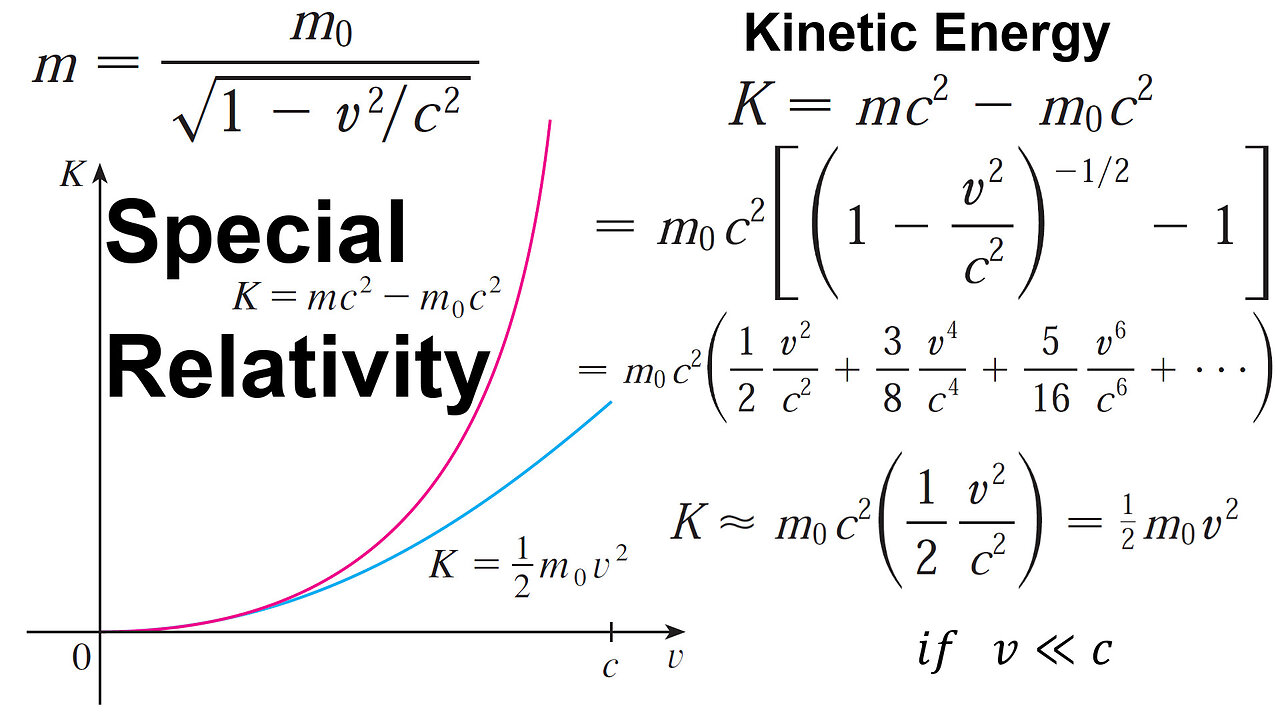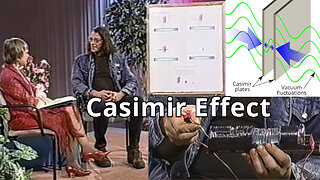Premium Only Content

Example 3: Einstein's Theory of Special Relativity vs. Classical Theory for Kinetic Energy
In this video I approximate Albert Einstein's kinetic energy equation from his theory of special relativity and show that at low velocities the equation agrees with the classical Newtonian equation K = (1/2)mv^2. In special relativity, the mass of a moving object is a function of its velocity and the speed of light in a vacuum, with the property that the mass goes to infinity as the velocity approaches the speed of light. The kinetic energy is the difference between its total energy (E = mc^2) and its energy at rest (m_o·c^2 where m_o is the rest mass). Plugging in the realistic mass into the kinetic energy equation we obtain an equation which can be approximated with the Maclaurin binomial series. When the velocity is much less than the speed of light, then the equation simplifies into the classical kinetic energy equation. I show that the error for this approximation is extremely small when the velocity is less than 100 m / s or 223.7 miles / hour (mph). This is a great illustration of using Taylor polynomials in a physics to gain insight into the equations.
Timestamps:
- Applications to Physics: 0:00
- Example 3: Einstein's theory of special relativity: 0:33
- Solution to (a): At small velocities Kinetic Energy equation agrees with classical Newtonian physics: 1:53
- Approximate kinetic energy as a Maclaurin binomial series: 3:33
- Plugging binomial series into kinetic energy equation: 10:42
- At low velocities, can use just first term, which matches classical theory: 14:12
- Solution to (b): Using Taylor's Inequality to calculate difference between classical theory and relativity: 15:49
- Solving the 2nd derivative of kinetic energy: 18:01
- Value of M or 2nd derivative when velocity is less than 100 m/s: 21:31
- Plugging in speed of light to get absolute maximum remainder: 23:26
- Remainder is less than: 4.17x10^(-10) times rest mass: 25:54
- Graphing kinetic energy in special relativity vs classical theory: 27:45
- Graphing in Desmos graphing calculator: https://www.desmos.com/calculator/qhskha70eg: 28:10
- Mass goes to infinity as velocity gets closer to speed of light: https://www.desmos.com/calculator/0limsnshiy: 29:22
Full video, notes, and playlists:
- Full video and playlist: https://www.youtube.com/playlist?list=PLai3U8-WIK0F76sIU8xm09oqBTq1mlry3
- HIVE notes: https://peakd.com/hive-128780/@mes/infinite-sequences-and-series-applications-of-taylor-polynomials
- Infinite Sequences and Series: https://www.youtube.com/playlist?list=PLai3U8-WIK0EXHAJ3vRg0T_kKEyPah1Lz .
------------------------------------------------------
Become a MES Super Fan! https://www.youtube.com/channel/UCUUBq1GPBvvGNz7dpgO14Ow/join
DONATE! ʕ •ᴥ•ʔ https://mes.fm/donate
SUBSCRIBE via EMAIL: https://mes.fm/subscribe
MES Links: https://mes.fm/links
MES Truth: https://mes.fm/truth
Official Website: https://MES.fm
Hive: https://peakd.com/@mes
Email me: contact@mes.fm
Free Calculators: https://mes.fm/calculators
BMI Calculator: https://bmicalculator.mes.fm
Grade Calculator: https://gradecalculator.mes.fm
Mortgage Calculator: https://mortgagecalculator.mes.fm
Percentage Calculator: https://percentagecalculator.mes.fm
Free Online Tools: https://mes.fm/tools
iPhone and Android Apps: https://mes.fm/mobile-apps
-
 59:15
59:15
Math Easy Solutions
6 days ago $0.03 earnedJohn Hutchison Interview on the Elaine Smitha Show (2000): What's New in Free Energy?
1632 -
 4:04:20
4:04:20
Nerdrotic
9 hours ago $43.30 earnedAmazon Takes 007! Hollywood is Lost, Disney Cancels WHO? | Friday Night Tights 342 /w ItsAGundam
150K27 -
 43:27
43:27
Tucker Carlson
8 hours agoRay Dalio: America’s Hidden Civil War, and the Race to Beat China in Tech, Economics, and Academia
143K170 -
 56:56
56:56
Candace Show Podcast
9 hours agoEXCLUSIVE: Taylor Swift Will Be Deposed. | Candace Ep 150
150K145 -
 1:03:52
1:03:52
IsaacButterfield
5 hours ago $2.58 earnedRepublican Vs 25 Transgender Activists | Jewish Outrage | Lizzo Loses All the Weight
37.8K13 -
 1:10:23
1:10:23
Edge of Wonder
9 hours agoChinese Biochips Hacking Minds? Quantum Control & Journey Song Mandela Effect
66.4K7 -
 2:15:46
2:15:46
Quite Frankly
12 hours ago"Ghosts, Robotics, and OBE's" ft. Dr. Albert Taylor 2/21/25
62.9K17 -
 55:52
55:52
LFA TV
1 day agoMaking Germany Great Again | TRUMPET DAILY 2.21.25 7PM
42.4K9 -
 1:52:26
1:52:26
2 MIKES LIVE
8 hours ago2 MIKES LIVE #183 Open Mike Friday with Hannah Faulkner and Adelia Kirchner!
30.5K -
 12:09
12:09
MrBigKid
8 hours ago $2.69 earnedNew Mossberg 590R: Tactical Homestead Defender
37K7